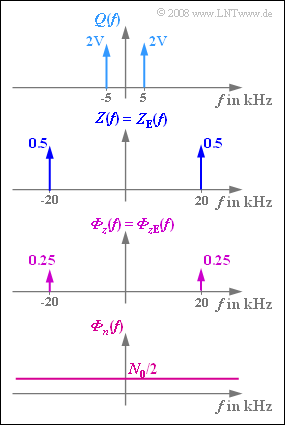Exercise 2.6Z: Signal-to-Noise Ratio
In the following exercise, we assume:
- a cosine source signal:
- $$ q(t) = 4 \,{\rm V} \cdot \cos(2 \pi \cdot 5\,{\rm kHz} \cdot t )\hspace{0.05cm},$$
- DSB–AM by multiplication with
- $$z(t) = 1 \cdot \cos(2 \pi \cdot 20\,{\rm kHz} \cdot t )\hspace{0.05cm},$$
- a frequency-independent attenuation on the channel corresponding to $α_{\rm K} = 10^{–4}$,
- additive white input noise with noise power density $N_0 = 4 · 10^{–19} \ \rm W/Hz$,
- phase- and frequency-synchronous demodulation by multiplication with the same $z(t)$ as at the transmitter,
- a rectangular low-pass at the synchronous demodulator with cutoff frequency $f_{\rm E} = 5 \ \rm kHz$.
In the graph, these specifications are shown in the spectral domain. It should be explicitly mentioned that the power density spectrum ${\it Φ}_z(f)$ of the cosine oscillation $z(t)$ is composed of two Dirac lines at $±f_{\rm T}$ zusammensetzt, as is the amplitude spectrum $Z(f)$ , but with weight $A^2/4$ instead of $A/2$. The amplitude should always be set to $A=1$ in this exercise.
The sink signal $v(t)$ is composed of the useful component $α · q(t)$ and the noise component $ε(t)$ . Thus, the general rule for the signal-to-noise power ratio to be determined is:
- $$ \rho_{v } = \frac{\alpha^2 \cdot P_q}{P_\varepsilon}\hspace{0.05cm}.$$
This important quality criterion is often abbreviated to SNR ( Signal–to–Noise–Ratio).
Hints:
- This exercise belongs to the chapter Synchronous Demodulation.
- Particular reference is made to the pages Calculating noise power and Relationship between $P_q$ and $P_{\rm S}$.
- Please note that the variables $α$ and $α_{\rm K}$ need not be the same.
- All powers refer to a resistance of $R = 50 \ \rm Ω$ with the exception of (1) .
- For DSB-AM without a carrier, $P_q$ also represents the transmit power $P_{\rm S}$ .
Questions
Musterlösung
- Die Leistung ergibt sich aus dem Integral über das LDS und ist somit gleich der Summe der beiden Diracgewichte. Mit $A = 4 \ \rm V$ erhält man somit für die Leistung des Quellensignals:
- $$ P_q = \frac{A^2}{2} \hspace{0.15cm}\underline {= 8\,{\rm V^2}} \hspace{0.05cm}.$$
- Beim Modulationsverfahren „ZSB-AM ohne Träger” ist dies gleichzeitig die auf den Einheitswiderstand $1\ \rm Ω$ bezogene Sendeleistung $P_{\rm S}$.
(2) Nach den elementaren Gesetzen der Elektrotechnik gilt:
- $$P_q = \frac{8\,{\rm V^2}}{50\,{\Omega}} \hspace{0.15cm}\underline {= 0.16\,{\rm W}} \hspace{0.05cm}.$$
(3) Im Theorieteil wird gezeigt, dass bei idealen Voraussetzungen $v(t) = q(t)$ gilt. Zu berücksichtigen ist allerdings:
- Aus der Grafik erkennt man, dass $Z_{\rm E}(f) = Z(f)$ gilt. Damit hat das empfängerseitige Trägersignal $z_{\rm E}(t)$ wie $z(t)$ die Amplitude $1$.
- Im Idealfall müsste aber das empfängerseitige Trägersignal $z_{\rm E}(t)$ die Amplitude $2$ besitzen.
- Deshalb gilt gilt hier $υ(t) = q(t)/2$.
- Berücksichtigt man weiter die Kanaldämpfung $α_{\rm K} = 10^{–4}$, so erhält man das Endergebnis: $α\hspace{0.15cm}\underline { = 0.5 · 10^{–4}}.$
(4) Das Leistungsdichtespektrum des Produktes $n(t) · z(t)$ ergibt sich aus der Faltung der beiden Leistungsdichtespektren von $n(t)$ und $z(t)$:
- $$ {\it \Phi}_\varepsilon \hspace{0.01cm} '(f) = {\it \Phi}_n (f) \star {\it \Phi}_{z }(f)= \frac{N_0}{2} \star \left[\delta(f - f_{\rm T}) + \delta(f + f_{\rm T}) \right]= N_0 \hspace{0.05cm}.$$
- Für das Leistungsdichtespektrum des Signals $ε(t)$ nach dem Tiefpass erhält man eine Rechteckform mit dem gleichen Wert bei $f = 0$:
- $${\it \Phi}_\varepsilon (f) = {\it \Phi}_\varepsilon \hspace{0.01cm} '(f) \cdot |H_{\rm E}(f)|^2 \hspace{0.3cm}\Rightarrow \hspace{0.3cm} {\it \Phi}_\varepsilon (f=0)= N_0\hspace{0.15cm}\underline {= 4 \cdot 10^{-19}\,{\rm W/Hz}} \hspace{0.05cm}.$$
(5) Die Rauschleistung ist das Integral über die Rauschleistungsdichte:
- $$ P_{\varepsilon} = \int_{-f_{\rm E}}^{ + f_{\rm E}} {{\it \Phi}_\varepsilon (f)}\hspace{0.1cm}{\rm d}f = N_0 \cdot 2 f_{\rm E} = 4 \cdot 10^{-19}\,\frac{ \rm W}{\rm Hz} \cdot 10^{4}\,{\rm Hz} \hspace{0.15cm}\underline {= 4 \cdot 10^{-15}\,{\rm W}}\hspace{0.05cm}.$$
(6) Aus den Ergebnissen der Teilaufgaben (2), (3) und (5) folgt:
- $$\rho_{v } = \frac{\alpha^2 \cdot P_q}{P_\varepsilon} = \frac{(0.5 \cdot 10^{-4})^2 \cdot 0.16\,{\rm W}}{4 \cdot 10^{-15}\,{\rm W}} \hspace{0.15cm}\underline {= 100000} \hspace{0.3cm}\Rightarrow \hspace{0.3cm}10 \cdot {\rm lg }\hspace{0.1cm}\rho_{v } \hspace{0.15cm}\underline {= 50\,{\rm dB}}\hspace{0.05cm}.$$
